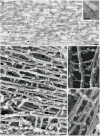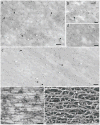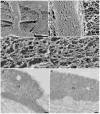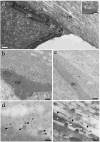Tectorins crosslink type II collagen fibrils and connect the tectorial membrane to the spiral limbus
- PMID: 26806019
- PMCID: PMC4805521
- DOI: 10.1016/j.jsb.2016.01.006
Tectorins crosslink type II collagen fibrils and connect the tectorial membrane to the spiral limbus
Abstract
All inner ear organs possess extracellular matrix appendices over the sensory epithelia that are crucial for their proper function. The tectorial membrane (TM) is a gelatinous acellular membrane located above the hearing sensory epithelium and is composed mostly of type II collagen, and α and β tectorins. TM molecules self-assemble in the endolymph fluid environment, interacting medially with the spiral limbus and distally with the outer hair cell stereocilia. Here, we used immunogold labeling in freeze-substituted mouse cochleae to assess the fine localization of both tectorins in distinct TM regions. We observed that the TM adheres to the spiral limbus through a dense thin matrix enriched in α- and β-tectorin, both likely bound to the membranes of interdental cells. Freeze-etching images revealed that type II collagen fibrils were crosslinked by short thin filaments (4±1.5nm, width), resembling another collagen type protein, or chains of globular elements (15±3.2nm, diameter). Gold-particles for both tectorins also localized adjacent to the type II collagen fibrils, suggesting that these globules might be composed essentially of α- and β-tectorins. Finally, the presence of gold-particles at the TM lower side suggests that the outer hair cell stereocilia membrane has a molecular partner to tectorins, probably stereocilin, allowing the physical connection between the TM and the organ of Corti.
Keywords: Electron microscopy; Extracellular matrix; Immunogold-labeling; Tectorial membrane; Tectorins.
Copyright © 2016 Elsevier Inc. All rights reserved.
Conflict of interest statement
We declare no conflict of interest.
Figures






References
-
- Fichard A, Kleman JP, Ruggiero F. Another look at collagenV and XI molecules. Matrix Biol. 1995;14:515–31. - PubMed
Publication types
MeSH terms
Substances
Grants and funding
LinkOut - more resources
Full Text Sources
Other Literature Sources

